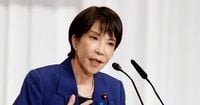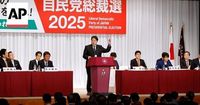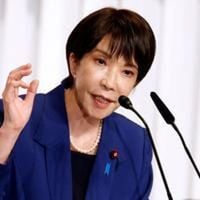Japan’s political landscape is bracing for a pivotal moment as the ruling Liberal Democratic Party (LDP) officially kicked off its leadership race on September 22, 2025. With Prime Minister Shigeru Ishiba stepping down after a bruising period of electoral setbacks, the party faces a crossroads: Can it restore public trust and reassert its dominance, or will the drift toward rival populist parties continue? The answer may hinge on the outcome of the LDP’s October 4 leadership vote, a contest that has drawn intense scrutiny from both domestic and international observers.
Five prominent lawmakers have thrown their hats into the ring, each bringing a distinct vision for the party and the nation. The candidates—Shinjiro Koizumi, Sanae Takaichi, Yoshimasa Hayashi, Toshimitsu Motegi, and Takayuki Kobayashi—are all current or former Cabinet ministers. Their candidacies were officially filed as the campaign period commenced, marking the start of a high-stakes race that could shape Japan’s direction for years to come, according to The Jiji Press and Reuters.
The urgency of the moment is palpable. The LDP, once the unassailable force in Japanese politics, has seen its coalition with Komeito lose majorities in both houses of parliament. Recent elections have exposed vulnerabilities, with voters drifting toward opposition and populist parties. As Reuters reports, the leadership contest is not just about replacing Ishiba—it’s about rebranding the party itself and stemming the loss of support that has left the ruling coalition on shaky ground.
“Change, LDP” is the slogan emblazoned on campaign materials, signaling a recognition that business as usual won’t cut it. The winner of the October 4 vote will need to act swiftly to address rising prices and steady the party’s fortunes. The new leader will also have to navigate the tricky waters of parliamentary cooperation, as the LDP’s diminished majority means that opposition support is essential for stable governance.
Unlike a general election, the LDP’s leadership vote is a closed affair. Only 295 party parliamentarians and nearly one million dues-paying grassroots members—less than 1% of Japan’s eligible voters—will have a say. If no candidate secures a majority in the first round, a runoff between the top two will decide the outcome. The winner is all but assured to become prime minister, given the LDP’s status as the largest party in the lower house. However, as AP notes, the new leader will still need backing from at least some opposition lawmakers in a parliamentary vote held within days of the party decision.
Shinjiro Koizumi, 44, is perhaps the most recognizable face in the race. The son of former Prime Minister Junichiro Koizumi, he’s making his second bid for the top job after running against Ishiba last year. As agriculture minister, Koizumi took decisive action to stabilize rice prices by releasing emergency stockpiles, earning him praise for responsiveness in a time of economic anxiety. In his campaign, Koizumi has promised to “rebuild the party and listen to the people’s voices more closely,” focusing on issues like inflation, immigration, and public safety. If elected, he would be Japan’s youngest leader since Hirobumi Ito in 1885.
Sanae Takaichi, 64, is another frontrunner, bringing both experience and controversy to the contest. A protégé of former Prime Minister Shinzo Abe, Takaichi is known for her nationalistic views and regular visits to the Yasukuni Shrine—actions that have drawn criticism from China and South Korea. She supports increased public spending, a robust military, and opposes both a female emperor and changes to civil law that would allow married couples to keep separate surnames. In a recent policy speech, Takaichi said, “I want good ties with China, as an important neighbor,” but stressed that her sharper comments about China are “mostly related to economics.” If chosen, she would make history as Japan’s first female prime minister—a milestone in a country that ranks low globally for gender equality in politics.
Yoshimasa Hayashi, 64, currently serves as Chief Cabinet Secretary and is seen as a steady hand. With a background that includes stints as foreign, defense, and education minister, Hayashi has promised “steady wage increases, a strong economy and defense.” A Harvard graduate and musician, he’s known for his approachable style and willingness to work across party lines. In an interview with Reuters, Hayashi pledged to “compile a package of relief measures to cushion the blow from the rising cost of living and bolster disaster relief.”
Toshimitsu Motegi, 69, brings a reputation as a tough negotiator, having served as both foreign and trade minister. He’s credited with deepening the Japan-U.S. alliance and handling complex trade talks during President Trump’s first term. Motegi has declared that the alliance with the U.S. is “key to our country’s diplomacy” and has expressed openness to forming a coalition with opposition parties if needed to ensure stability.
Takayuki Kobayashi, 50, rounds out the field. A former economic security minister, he appeals to the LDP’s conservative base with calls for stronger growth, tougher restrictions on foreign workers, and increased defense spending—arguing that the current target of 2% of GDP is “insufficient.” Kobayashi has also proposed temporary flat-rate tax reductions and wants tighter regulations on foreign acquisitions of Japanese companies and land.
All five candidates ran in last year’s party presidential election, and recent media polls suggest that Koizumi and Takaichi are leading the pack. As The Jiji Press reports, the candidates have spent the early days of the campaign debating economic measures to combat inflation and strategies for party reconstruction after the LDP’s defeat in the July 2025 House of Councillors election. Cooperation with opposition parties—especially the Japan Innovation Party (Ishin) and the Democratic Party for the People—has emerged as a key theme. Koizumi has already reached out to Ishin, visiting the Osaka Expo with party leader Hirofumi Yoshimura, while Hayashi and Motegi have signaled their willingness to work with opposition lawmakers to ensure stable governance.
The stakes are high, not only for the LDP but for Japan’s future. The new leader will inherit a party in flux, a public wary of political instability, and a raft of challenges ranging from inflation to national security. As the October 4 vote approaches, all eyes are on the LDP—and the five contenders vying to shape the next chapter of Japanese politics.
The outcome of this leadership race will resonate well beyond party headquarters in Tokyo, influencing Japan’s domestic agenda and its role on the world stage. In a climate of uncertainty, the country waits to see who will rise to the occasion and whether “Change, LDP” will prove more than just a campaign slogan.



